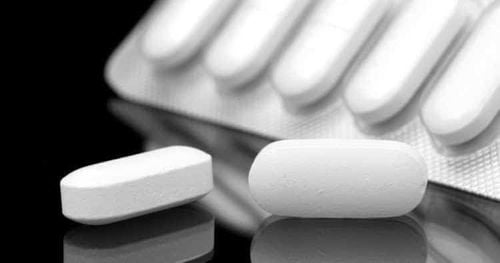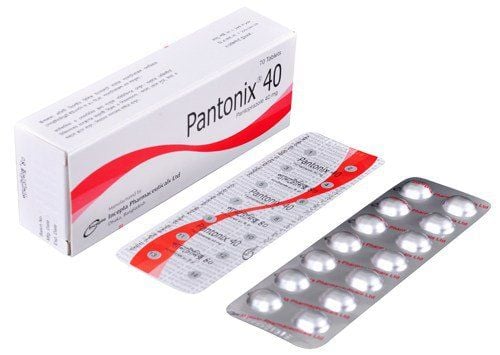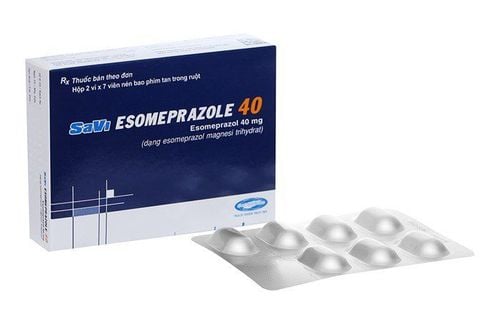This is an automatically translated article.
Pantoloc (pantoprazole) is a line of drugs for the treatment of diseases related to acid in the stomach and intestines. The drug works to improve the health status of patients with stomach pain. So what is Pantoloc, what are its uses and side effects when used?
1. What is Pantoloc?
Pantoloc is manufactured by Takeda Company GmbH. The main active ingredient in the drug is Pantoprazole. The drug is in the form of tablets in blister packs. Used in cases of gastroesophageal reflux, oesophagitis, peptic ulcer, kill Helicobacter bacteria, Zollinger Ellison syndrome, reduce the amount of acid in the stomach.
2. Indications for the drug Pantoloc
2.1. Indications Pantoloc is indicated for use in adults and adolescents 12 years of age and older, for the treatment of reflux esophagitis. Treatment of Helicobacter pylori bacteria, gastric ulcer patients. Reduces recurrence of duodenal and gastric ulcers caused by this bacterium. Treatment of Zollinger Ellison syndrome, all pathological hypersecretory conditions.
2.2. Pharmacodynamics Pantoloc includes the active ingredient Pantoprazole as a substitute for benzimidazole. Has an inhibitory effect on the secretion of hydrochloric acid in the stomach. By selectively inhibiting the proton pump of gastric parietal cells.
The active ingredient Pantoprazole in Pantoloc is actively metabolized in the acidic environment in the parietal cells of the stomach. In order to inhibit the enzymes H+, K+–ATPase, which produce hydrochloric acid in the stomach. This process is dose-dependent and affects both basal secretion and increased production of acid hydrochloride. Usually, symptoms disappear within 2 weeks of treatment.
Pantoprazole can help reduce acidity in the stomach, increasing gastrin levels proportionally to reduced acidity, reversible. Because pantoprazole binds enzymes at the radioreceptor site in facial cells, it may cause specific inhibition of acid hydrochloride secretion by stimulating other substances (eg, acetylcholine, histamine, gastrin).
2.3. Pharmacokinetics Absorption: Pantoprazole is rapidly absorbed and reaches peak plasma concentrations even after a single dose. On average, about 2.5 hours after administration, peak plasma concentrations are reached between 2μg/mL – 3μg/mL and these values remain unchanged after repeated administration. The pharmacokinetics were unchanged after the first and repeated doses. The dose range from 10-80 mg pantoprazole pharmacokinetics in plasma is linear following both oral and intravenous administration. Bioavailability is reported to be about 77%. Dosing with food has no effect on AUC, peak serum concentrations should not affect bioavailability. Distribution: Approximately 98% of the active ingredient pantoprazole is bound to plasma proteins. The volume of distribution is about 0.15L/kg. Metabolism: The drug is almost completely metabolised by the liver. The major route of metabolism is demethylation by CYP2C19 and subsequent conjugation with sulfate; other pathways include oxidation by CYP3A4. Elimination: The half-life is about 1 hour and the clearance is about 0.1 L/h/kg. However, due to the selective binding of the active ingredient pantoprazole to the proton pumps, some cases of drug elimination are slow. The metabolites of pantoprazole are eliminated mainly by the kidneys (about 80%), the remainder is eliminated in the faeces. The major metabolite in both serum and urine is desmethyl pantoprazole, which is conjugated with sulfate. The half-life of about 1.5 hours is not much longer than that of pantoprazole.
3. Dosage and how to use Pantoloc
3.1. Dosage Usually in most cases will take 1 tablet. However, in special cases, the dose can be doubled from 2 tablets per day.
Cases of gastric and duodenal ulcers (Helicobacter pylori + infection): The usual dose is 1 tablet/day. The dose may be doubled at subsequent visits. Treatment of gastric ulcer usually lasts 4 to 8 weeks, duodenal ulcer from 2 to 4 weeks. Treatment of symptoms of gastroesophageal reflux, esophagitis: dose 1 tablet/day. Treatment can last 4 to 8 weeks. Treatment of Zollinger-Ellison syndrome, a lot of acid in the stomach: Usually take 2 tablets / day, 1 hour before meals. In case of severe liver failure, the dose will be reduced to 1 tablet once every 2 days. If monitoring shows an increase in liver enzyme values, stop taking the drug. Elderly people or renal failure: Do not exceed 1 tablet of 40mg/day. For the case of elderly people taking combination therapy to kill Helicobacter pylori use 2 tablets / day for 1 week of treatment. In case of intravenous dose: Should only be used when oral administration is not suitable. Dosage is 1 vial of 10mg pantoprazole per day. When preparing the injection drug, 10ml of physiological NaCl solution will be injected into the vial containing lyophilized pantoprazole (This solution can be used for direct injection after dilution with 100ml of 5% or 10% NaCl solution, glucose.). The pH value is 9. Pantoloc i.v is administered intravenously over a period of 2 - 15 minutes. The reconstituted solution is used as soon as 3 hours after preparation.
3.2. How to use Patients should take the drug 1 hour before breakfast, take the whole tablet with water. Do not chew, crush or break the tablet while taking it. In combination therapy for the eradication of Helicobacter pylori, take the second Pantoloc tablet before dinner.
If you forget to take the medicine on time, the patient should pay attention not to take the make up dose late in the day, but should continue to take it the next day.
Usually treatment dose for 7 days or can last up to 2 weeks. However, at the treatment stage of gastric ulcer and reflux esophagitis can last up to 4 weeks. If 4 weeks is not enough, pantoloc can be used for an additional 4 weeks but should not exceed 8 weeks.
4. Contraindications and cautions when using Pantoloc
4.1. Contraindications Cases of contraindications to the use of Pantoloc:
Combination of other drugs that destroy Helicobacter pylori in the treatment of moderate to severe liver and kidney dysfunction. There are currently no accurate data on efficacy and safety for use. History of hypersensitivity to any component of the drug or to any of the excipients. Do not combine treatment with atazanavir. Children under 12 years old. People who are being treated for other diseases in medicine containing rilpivirine. 4.2. Precautions for use In case of severe hepatic impairment: regular monitoring of enzymes is required during treatment, especially during long-term use. In case of increased liver enzymes, treatment must be stopped immediately. In the case of combination drug therapy, the individual product characteristics summary should be followed. With gastric malignancy: if there are manifestations such as vomiting blood, difficulty swallowing, anemia, black stools, weight loss, decreased attention,... More studies should be conducted to evaluate if the symptoms are symptomatic. Malignant peptic ulcer disease persists despite appropriate treatment. Combination therapy with HIV protease inhibitors is not recommended. Depending on gastric pH-dependent absorption such as atazanavir due to significant reduction in bioavailability of these drugs. In patients with Zollinger–Ellison syndrome, other pathological hypersecretory conditions require long-term treatment. However, vitamin B12 absorption may be reduced, due to decreased or deficient gastric hydrochloric acid. In long-term treatment beyond 1 year, regular monitoring is required. Bacterial Gastrointestinal Infections: Pantoprazole can be expected to increase the number of bacteria normally present in the upper gastrointestinal tract. Treatment with Pantoloc may slightly increase gastrointestinal infections caused by bacteria such as Salmonella and Campylobacter or C. difficile. Severe hypomagnesaemia, including symptoms of delirium, spasticity, dizziness, vertigo, ventricular arrhythmias, etc., have been reported in many cases treated with pantoprazole for at least 3 months, and are common. in the case of 1 year. However, symptoms can begin silently and go unnoticed. If used in high doses and for longer than 1 year, there is a moderate increase in the risk of fractures (hip, wrist and spine). Occurs mainly in the elderly or with other risk factors. In this case, adequate vitamin D and calcium should be used. Subacute cutaneous lupus erythematosus: If lesions appear on the skin with symptoms of joint pain. A physician should be consulted immediately and discontinuation of Pantoloc should be considered.
5. Side effects when using Pantoloc?
Pantoloc is a fairly safe drug for many subjects. However, during use, there are still some common side effects such as: nausea, diarrhea, headache, constipation, flatulence, ..
Here are some rare and serious side effects. important. Specific:
Severe allergy symptoms: difficulty swallowing, rash, difficulty breathing, swelling of the tongue/throat, facial edema, severe dizziness, rapid heart rate and profuse sweating. Severe skin signs: bleeding in the face and genitals. The skin becomes more sensitive to light and blistering occurs. Other severe symptoms: high fever, rash, jaundice, white eyes (due to liver damage), enlarged kidneys, urinary frequency, blood in urine, lower back pain... If taking the drug for more than 3 months, the amount of magnesium Blood levels will be reduced, causing conditions such as lightheadedness, dizziness, muscle fatigue, muscle tremors and jerks, disorientation, tachycardia... Therefore, blood magnesium levels should be monitored regularly. Rash Sleep disorders Joint pain, bone fractures Unusual weight changes Fatigue, exhaustion,...
6. Drug interactions when used with Pantoloc
The absorption of the drug depends on the pH in the stomach. Theoretically, the potential for pharmacokinetic interactions when pantoloc is co-administered with drugs with gastric pH dependent absorption, could increase/decrease drug absorption with increasing gastric pH. Pantoprazole is extensively metabolised in the liver, primarily by cytochrome P450 (CYP) isoenzyme 2C19, to a lesser extent by isoenzymes CYP3A4, CYP2D6 and CYP2C9. In clinical trials, no significant interactions were observed between pantoloc and other drugs metabolised via the same isoenzyme. When warfarin is co-administered with pantoprazole or proton pump inhibitors, there is a risk of abnormal bleeding and death. Frequent monitoring of increases in INR and prothrombin time is required when pantoprazole is co-administered with warfarin. May delay absorption and reduce bioavailability of proton pump inhibitors. Therefore, a proton pump inhibitor should be administered at least 30 minutes before sucralfate. Pantoloc (pantoprazole) is a line of drugs for the treatment of diseases related to acid in the stomach and intestines. The drug works to improve the health status of patients with stomach pain. To ensure the effectiveness of treatment and avoid unwanted side effects, patients need to strictly follow the instructions of the doctor, professional pharmacist.
Follow Vinmec International General Hospital website to get more health, nutrition and beauty information to protect the health of yourself and your loved ones in your family.
Please dial HOTLINE for more information or register for an appointment HERE. Download MyVinmec app to make appointments faster and to manage your bookings easily.













